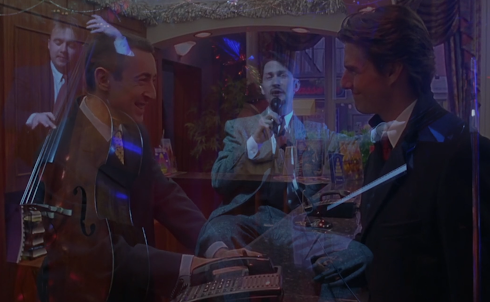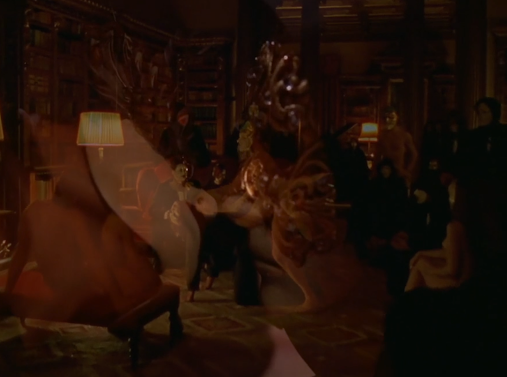Some stills from an experiment inspired by John Fell Ryan's The Shining Forwards and Backwards. The experiment is little more than applying a similar method to a different Kubrick film. Visually and aesthetically, Eyes Wide Shut is far more blurry, messy, and organic in comparison to The Shining. Not all of the superimpositions are particularly impressive; tracking shots and dark interiors sometimes make the original image more blurred and confused. The Shining is "gothic" in nature: hard lines, stark contrasts, sharp edges, geometrical, etc. Eyes Wide Shut is not - it relies more on dream logic and dream aesthetic. Nonetheless, there are some striking and revealing superimpositions to be found. I've chosen the most interesting ones to include in this post. Descriptions are under each image.
Search This Blog
Sunday, October 25, 2020
Eyes Wide Shut Forwards and Backwards
Alice's dream vs. Bill entering "Sharky's" cafe; Alice appearing devilish.
Alice's patronizing contrapposto pose vs. Bill and Victor's game of "no games."
Alice describing the sailor in the hotel lobby vs. the revolving doors of the morgue lobby Bill enters.
Dr. Bill and nurse examine suspiciously attractive female patient in Bill's "daily" montage vs. Victor and Bill's philosophical waltz.
Bill staring in disbelief at Alice vs. Bill ordering a cappuccino at Sharky's. Note how the wreaths align with Bill's eyes, while the garland trails from his lips.
Alice's dream vs. Bill's sighting of the bald spy following him.
Bill shattered by Alice's confession vs. Spy. Note the semi-circle window which falls above Bill's left eye, the red street-light in Bill's left eye, the lighted tree stemming from Bill's right eye, and the fire-escape ladder. The superimposition suggests Bill's diverse set of masks. The ladder relates to various ladders in The Shining, which allude to Masonic symbology, and, by extension, Biblical symbols, like Jacob's Ladder in the Awakening of Jacob story, from which this blog takes its name.
Thoughtful Bill vs. night-time street. Note red globes near his eyes, reminiscent of the red circle at Somerton.
Cold, pensive Bill riding in taxi vs. empty nighttime street and lights.
Seated Bill with Marion vs. Bill and Sally.
Exhausted Dr. Bill vs. symmetrical Bill and Marion. Curiously similar to the middle-school textbook example of twin lamps or glasses to illustrate the idea of optical illusions. The center form almost looks like a woman in a blue dress.
Bill inquiring about Nick at Hotel Jason vs. Nick Nightingale introducing his band at Sonata Cafe. Nick's "manspread" pose ironically dovetails with Alan Cumming's flamboyant, sexualized verbiage he uses telling the story of Nick's checking out of the hotel. Note again that the clerk sexualizes the violent nature of Nick's departure. He sees the erotic in the violent.
Bill coming home to Alice vs. Bill bargaining with Milich.
Alice's confused nightmare vs. Milich showing Bill the costume room.
Bill laying down after his long night vs. Milich and Bill talking.
Bill in taxi vs. Bill at masked ball. Note Bill's eyes are open at the ball and closed in the taxi.
Bill's "trial" or "mock trial" at Somerton vs. the trip there.
Unnamed woman presumed to be Mandy preparing for the consequences of redeeming Bill vs. fade/montage of Bill's taxi passing through a community (Oyster Bay). Note the twin gables of the building which bear a strange resemblance to a mask (or hood). As Julie Kearns has noted, this building is actually the Oyster Bay Funeral Home. Note the symbolism of "oyster" - Aphrodite, the female sex, Hedonistic pleasure, "aphrodisiac" food, etc., as well as the lurking but obvious theme of Sex and Death.
"Plague Doctor" masked man emerging to take the unnamed woman vs. the pine trees at Somerton when Bill first arrives (recall the Pinoli restaurant where the Magic Circle first formed in 1905, London). The particular cloak and mask supposedly play on the real uniform worn by plague doctors in 17th century Europe, beginning in Naples. The beak of the mask was stuffed with herbs to filter the air which was thought to contain miasmas, or airborne diseases. The eye-holes were covered with glass to protect the eyes from exposure to said "foul air." Cloak, hat/hood, gloves, and cane were used to protect the doctor who would treat all people.
"Red cloak" presiding over Somerton vs. Bill and cabbie talking payments.
Bill tearing a $100 bill in half for the cabbie vs. establishing shot of Bill's "trial" just as the unnamed woman appears on the balcony to "redeem" him.
The unnamed woman watching the circular gathering from the balcony vs. Bill giving the password to the two guards.
Bill entering Somerton without mask vs. Bill removing his mask during his "trial."
What we imagine to be Victor and his wife Illona looking down on Bill vs. Bill having a serious
talk with the topless unnamed woman in one of Somerton's halls.
Bill and the unnamed woman kissing through masks before leaving the main room vs. the man penetrating a masked woman cartoonishly in a reading room. Note the man aligns with Bill's mouth and the woman aligns with the unnamed woman's mouth.
Bill making a move on Sally (before Sally insists on telling Bill of Domino's HIV-positive diagnosis) vs. Marion's look of intrigue at Bill.
Subscribe to:
Post Comments (Atom)
Rival camps
Some things keep you up at night. In the universe of Kubrick, and more specifically, the world of Eyes Wide Shut , we are bound to comes acr...

-
When Bill makes his return trip to the Long Island estate, Somerton, we see him pass over Manhattan Bridge, the same bridge he crossed the p...
-
Though the word "Aleph" is nearly synonymous with the late Argentine author, Jorge Luis Borges, and makes a few appearances in acr...
-
Jack Torrance (Jack Nicholson) and George Peatty (Elisha Cook) share a similar physical appearance - that is to say, Nicholson and Cook shar...































No comments:
Post a Comment